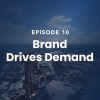B2B often follows about a decade behind B2C. This is especially true in marketing. If you want to know where B2B is going, just take cues from B2C. In fact, the lines are now more blurred together than ever before. As a CMO turned early-stage investor, marketing leaders at companies of all sizes would regularly ask me: which is more important, demand-gen, or branding?
My answer now remains pretty much the same as it did even all those years ago – stop thinking about demand-gen and branding in silos. Frankly, you’re setting yourself up for failure.
Since then, I’ve taken on the role as CEO and I can say, this holds true more than ever. Not only does brand drive demand, it now plays a role across the entire customer funnel. It’s time we took a page out of the B2C playbook and stop treating these two (very important) functions separately.
Branding Is the Heartbeat of Demand-Gen
An effective demand-gen strategy means new eyeballs on your brand, so what do those leads see at first interaction? And even more importantly, how do they feel? If your brand isn’t a delightful experience out of the gate, that awareness is wasted.
The most thoughtful brand experiences first build trust and then win business. From your website to your blog content to ebooks and more, every single touchpoint is a chance to communicate authenticity and value. Every inch of your brand efforts should help drive demand for your product. Investing in your brand now will literally pay off.
In today’s climate, customer retention is the new acquisition. Top of the funnel growth still matters, but keeping current customers happy provides the biggest opportunity for expansion. Marketers have shifted from a pure acquisition and growth marketing mindset to lifetime value. A brand built on delivering value and being a trusted partner will win demand long-term.
Customers Want a Trusted Partner, Not a Brand Promise
Stop leaning on missions and value statements to build trust with customers. Prove it instead.
Customers are seeking trusted partners. Expansion with current accounts is the best way to drive growth, but this is only possible when companies foster trust, earn credibility and actually deliver. Helping is truly the new selling. Understanding your customers’ goals and needs, and then working with them to achieve these, will outweigh lip-service about new features any day. When you play the long game, customers will remember how you respond.
To that end, we’re in the middle of a big shift. B2B marketers are making long-term platform bets with trusted partners over a cobblestone tech stack on solutions and integrations. The reality of our world today means companies need to become more efficient in capturing demand and driving sales efficiency. Customers are seeking the right platform and trusted partner to achieve true ROI more than ever.
Create a Movement
Many consumer brands have created a cult-like following because they’ve started a movement built around something meaningful. Whether it’s philanthropy, sustainability, adventure, etc. consumers crave association with brands that stand for something.
B2B buyers increasingly want the same. Decision makers (often multiple) want to associate with meaningful brands, so companies with an established and positive brand tend to have an advantage. But, don’t take my word for it. Here are a couple of examples of companies (you’ve probably heard of them) that have already figured this out:
G2 has quickly grown into the leading B2B software and services review platform by disrupting the traditional analyst model. Before G2, buying business software was cumbersome, risky and biased. With its seasonal reports that rank the best of, leaders, etc. of software categories, G2 has created a movement brands want to be a part of. Every board I review includes a G2 ranking these days, it’s now a badge of honor.
Salesforce may be a more obvious example as the company has built one of the most recognizable B2B brands with its TrailHead program, its philanthropic arm, and its best of breed platform for sales and marketing teams. Salesforce spurred the CRM movement and that’s been its biggest demand driver since day one.
As I’ve often said, your brand is not what you say it is, it’s the sum of the conversations happening about you. So, can you say with confidence that brand is your biggest demand driver?
